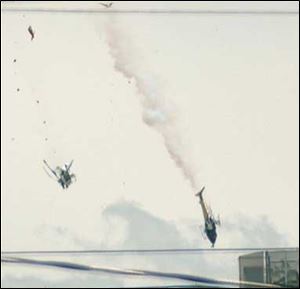
TV news copters collide while following police pursuit; 4 aboard die
7/27/2007
Two news helicopters fall after colliding in midair while covering a police pursuit in central Phoenix, Friday, July 27, 2007, killing everyone on both aircraft, police said. Both helicopters were from local television stations. KNXV-TV Channel 15 reported that one of the choppers belonged to its station. The other chopper was from KTVK Channel 3 in Phoenix.
PHOENIX Two news helicopters covering a police chase on live television collided and crashed to the ground today, killing all four people on board in a plunge that viewers saw as a jumble of spinning, broken images.
Both helicopters went down in a park in central Phoenix and caught fire. No one on the ground was hurt.
TV viewers did not actually witness the accident because cameras aboard both aircraft were pointed at the ground. But they saw video from one of the helicopters break up and begin to spin before the station abruptly switched to the studio.
Television station KNXV reported that it operated one of the choppers. The other was from KTVK. A pilot and photographer aboard each chopper were killed.
KNXV reporter Craig Smith, who was among the dead, was reporting live as police chased a man driving a construction truck who had fled a traffic stop. The man was driving erratically, hitting several cars and driving on the sidewalk at times.
Police had blown the truck s tires, and the man eventually parked it, then carjacked another vehicle nearby.
Just before the picture broke up, Smith said, Oh geez!
The station then switched to the studio and briefly showed regular programming, a soap opera, before announcing that the helicopter had crashed.
The man fleeing from police was later taken into custody. Police Chief Jack Harris suggested he could be charged in connection with the collision.
I believe you will want to talk to investigators, but I think he will be held responsible for any of the deaths from this tragedy, Harris told reporters at the scene. He did not elaborate.
The two choppers came down on the grass lawn in front of a boarded-up church at the park. Firefighters swarmed to the area as thick black smoke rose from the scene.
Rick Gotchie, an air conditioning contractor, was working nearby when he noticed the helicopters overhead. He said they began circling closer as he continued watching, and one appeared to get too close to the other.
I kept saying Go lower, go lower, but he didn t, Gotchie said. It was like a vacuum. They just got sucked into each other, and they both exploded and pieces were flying everywhere.
He said he ran to the crash site, but no one got out.
Federal Aviation Administration spokesman Ian Gregor said the pilots of the five news helicopters and one police chopper over the chase were not talking to air traffic controllers at the time, which is normal.
Typically air traffic controllers clear helicopters into an area where they can cover a chase like this, Gregor said. Once they are in the area, the pilots themselves are responsible for keeping themselves separated from other aircraft.
Pilots generally use a dedicated radio frequency to talk to each other and maintain their positions, Gregor said.
There is a high degree of coordination, Gregor said. To fly for a TV station you have to have a commercial rating, which means more (flight hours), more training.
Keith McCutchen, a past president of the National Broadcast Pilots Association and a news pilot for 11 years in Indianapolis, said pilot awareness is vital while on the scene of a story because of the many distractions that could spell trouble.
You are watching the scene. You have to bring your attention inside to look at the monitors to see what the audience is seeing so you can converse. But you re also having to direct your attention to the other aircraft flying around you.
You have to have your head on a swivel in those kinds of situations, he said.
In Indianapolis, when news choppers descend on a story, they pick different altitudes and radio their positions to other pilots.
I may be live on the air and one of the other guys may say, Hey, I m coming up on your left side, McCutchen said. I ll break away from what I m doing on the air and say, Roger, and then go back to talking.
Killed on board the KTVK chopper were pilot Scott Bowerbank and photographer Jim Cox. Smith and photographer Rick Krolak were aboard the KNXV aircraft, the stations reported.
Barbara Cochran, president of the Radio-Television News Directors Association in Washington, said the group does not track fatalities among helicopter news pilots, but she could not recall another example of two news choppers colliding while covering a story.
These pilots, they are very professional. They combine the skills of pilots and skills as journalists, she said.
Read more in later editions of The Blade and toledoblade.com